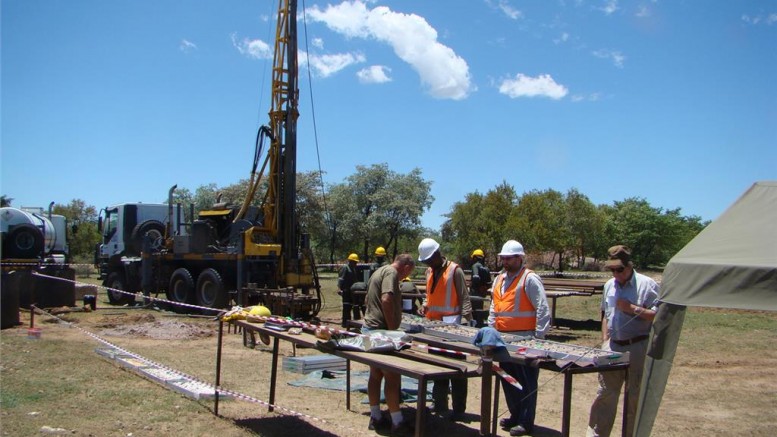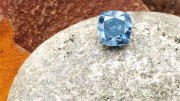Botswana is the world’s largest diamond producer by value and home to the incredibly rich and long-lived Tier 1 Orapa and Jwaneng mines, both owned by Debswana, a 50/50 joint venture of De Beers and the Botswana government.
Orapa, which started production in 1982 and ranks as the world’s richest diamond mine by value, contributes 60-70% of Debswana’s total revenue.
But Botswana still has more to offer.
The AK6 kimberlite at Lucara Diamond’s (TSX: LUC) Karowe mine was discovered in 1969 by De Beers, but not thought to be of significant size or grade until the early 2000s.
However, since production at Karowe began in 2012, it has been proven to host exceptional, high-value diamonds.
It also demonstrates that all the prospective ground in the country isn’t locked up by De Beers.
Mike DeWit, president and COO of Botswana-based junior Tsodilo Resources (TSXV: TSD), says he sees a renewed in interest in Botswana, particularly in diamonds. Lucara’s production of large diamonds is definitely part of the draw.
“(Karowe) sort of helps to make people aware well there are other kimberlites around still that may have these big stones,” he said in an interview from his office in Maun, Botswana.
With most of the country being covered by Kalahari sediments that have made exploration challenging, there’s a belief that there are substantial kimberlites in Botswana that have yet to be found (with new technology), DeWit says.
“The other thing is Botswana still rates with Namibia as the friendliest exploration nations in Africa and Botswana itself is elephant country for diamond deposits,” he adds.
Rather than focus on greenfield exploration companies are generally following up on previous discoveries that they hope will prove to have similarly unrecognized value as Karowe.
Here’s a sample of what some Canadian-listed companies are up to in Botswana.
Lucara Diamond
Lucara recently took a 500-tonne bulk sample from its BK02 kimberlite, about 30 km east of its Karowe mine. BK02 is located on one of two exploration licences in the Orapa kimberlite field awarded to Lucara in 2014. The concessions are on trend with Karowe and host three known kimberlites — BK02, AK11, and AK12.
BK2, which was discovered in 1967, is about 2.4 hectares at surface. Previous work has established that it is diamond-bearing, however, more work is required to determine its size, internal geology, grade and diamond quality.
Initial sample results are expected before the end of the year.
Lucara also plans some sampling work for AK11 and AK12, which are located just southeast of Debswana’s Orapa mine and 15 km north of Karowe, and has applied for drilling and bulk-sampling permits.
AK12, which is 1 to 2.5 hectares at surface, is known to be diamondiferous.
Tango Mining
Penny stock Tango Mining (TSXV: TGV) is in the midst of acquiring Firestone Diamonds’ (LSE: FDI) past-producing BK11 project. BK11 was in production for about a year before being put on care and maintenance in early 2012.
Recoveries at the mine weren’t as good as expected at BK11, which had been projected to produce 100,000 carats of diamonds a year.
The problem with the project was the mill, says Terry Tucker, executive chairman and interim CEO of Tango Mining.
“It’s very clear now from all the work that we’ve done that the plant they put in was not the proper plant for recovering diamonds from a kimberlite. They actually put in an alluvial diamond plant and their recoveries were terrible.”
The mine produced less than 15,400 carats in just over a year of production.
Firestone put the project on care and maintenance in 2011, after its financial backers declined to lend them money for a plant upgrade — preferring that the company instead focus on its much larger Liqhobong project in Lesotho.
Earlier this year, Tango struck a deal with Firestone to acquire BK11 for US$8 million. (The total cost of the deal is US$8.8 million as Tango has to acquire a minority shareholder’s 10% stake in Firestone’s Monak subsidiary, which holds the mining lease on BK11.)
Tango structured deal so it could make it public and reportable, Tucker says. “That allowed me to go out and access the investor world and allowed us access to the property,” he said.
Tango spent August and September completing a compliant resource and positive preliminary economic assessment (PEA) on BK11. The PEA didn’t take long to complete because a full feasibility study had been completed on BK11 in 2010.
While Tango does have some income from several metallurgical coal-washing plants in South Africa, and has recently put its Oena alluvial diamond mine in South Africa into
production, it is looking to raise US$25-27 million to put BK11 back into production. That will cover a US$15-million capital investment at BK11 for a new processing plant as well as the payment to Firestone. Under an amended agreement in October, Tango has until April 8, 2016 to close its financing and receive all approvals.
Under the PEA, completed in October, Tango expects it can have the mine back in production in early 2017, after financing is completed and an autogenous mill is installed.
It expects to produce nearly 570,000 carats over a seven-year mine life.
While Tucker doesn’t expect it will be easy to raise the money needed to put BK11 back into production in the current financing environment, he believes there is a good appetite for diamonds and for projects that are close to production.
“Since we put out the news release (about the BK11 acquisition), it’s been quite amazing the response that we’ve got,” he says, adding that the project’s proximity to Lucara’s Karowe mine, only 3 km away, has also helped spur interest.
“One of the unique things about this story is that there’s an existing mining licence, all the environmental permits are in place — we do have to amend one of the environmental permits to accommodate the new mill that we’re contemplating — but basically from closing of the financing to commencement of production, it could be twelve months.”
The BK11 diamonds were recently valued at US$260 per carat, and the study forecasts the project’s post-tax net present value (excluding acquisition costs) at US$40 million, using a discount rate of 8%. The study pegged BK11’s IRR (including acquisition costs) at 43%.
At presstime, Tango was trading at 1¢ per share, down from 5¢ in early October. Tucker says part of the company’s investor base was more interested in gold than diamonds and sold the stock “relentlessly” on release of the PEA.
Tsodilo Resources
Tsodilo Resources is a Botswana-based explorer with a promising iron ore project, a joint venture with First Quantum Minerals (TSX: FM) to explore for sedimentary-hosted copper, and several diamond projects.
At the moment, however, its BK16 project in central Botswana is its flagship project, says Tsodilo’s president and COO, Mike DeWit. The company has already done more than 3,600 metres of core drilling on the kimberlite, which was discovered in 1969 by De Beers.
“They did find diamonds in it, but they didn’t think that this was a proposition to go forward,” DeWit says. “It’s very similar to the story of AK6, Lucara’s deposit where people thought it was a small body, didn’t have a high grade, etc.”
Originally, BK16 was thought to be about 3.5 hectares, but drilling by Tsodilo since it acquired the exploration permit in October 2014 has shown it’s closer to 6 hectares in size.
De Beers also thought the kimberlite was very low grade because the bulk sample it took from BK16 was taken from the basalt breccia cover that lies over about two-thirds of the pipe.
“All the kimberlites in the Orapa province, including Lethlakane, which was mined extensively, and some of the Damtshaa mines here, have remnants of those basalt breccias on top of the pipe,” DeWit says.
“De Beers got their original sample out of this very diluted basalt breccia. We believe that clean kimberlite will have much better grades and we can see that from some of the drill results from other people. So we think there’s tremendous upside for it to be in the same sort of ballpark as AK6 in terms of grades.”
In the diluted zone, sample grades were under 2 carats per hundred tonnes (cpht). However, more recent bulk samples from outside of the diluted basalt breccia zone returned sample grades of up to 21 cpht.
The value of the BK16 diamonds has not yet been determined.
After doing detailed geophysics work and drilling, Tsodilo has completed a geological model and is now looking to raise $4 million to conduct a bulk sample by large-diameter drilling (LDD) at BK16.
DeWit says the LDD program will consist of about 11 24-inch holes drilled to 250 to 300 metres depth. The program will help establish whether BK16 hosts big diamonds, like AK6.
Tsodilo has also recovered a small, 25-carat parcel of diamonds, which look to be of good quality, from one of BK16’s previous operators.
Peregrine Diamonds
In October, Peregrine Diamonds (TSX: PGD) announced a four-hole, 570-metre drill program at its Moralane project in east-central Botsawana. Four targets will be tested with a rotary air-blast drill.
“The Moralane area hosts some of the most compelling and unexplained indicator mineral chemistry in Botswana,” said Herman Grutter, vice-president, technical services in a release. “These indicator minerals are compositionally unique within the Botswana context and cannot be explained by any of the known kimberlite clusters in the region.”
Grutter compared the area’s kimberlite indicator mineral (KIM) chemistry to prolific mines such as Finsch in South Africa and Jwaneng in Botswana.
At its Malolwane project, a 251-sq.-km area with little or no Kalahari cover, Peregrine has collected 284 KIM samples. Results from the program will be used to identify drill targets.
The junior also planned to collect KIM samples across 10 targets at its Gope project, 15 km north of Gem Diamonds’ (LSE: GEMD) Ghagoo mine, in late October, with follow-up drill testing planned for next year.
Soil sampling of magnetic anomalies is also planned for Peregrine’s Nata project, which lies along the same Cretaceous kimberlite emplacement corridor as Ghaghoo and Orapa.
Peregrine acquired its Botswana projects with the takeover of privately held Diamexstrat Botswana, announced in March and completed in July. As part of the deal, which gives Peregrine 5,746 sq. km of diamond prospecting licences in Botswana, it has assumed a $450,000 loan from vendor DES UK, granted it a 1% gross overriding royalty, and entered into a services agreement that will see DES UK manage the exploration program on the concessions.
Peregrine has budgeted $300,000 for the 2015 exploration program in Botswana.
Pangolin Diamonds
Pangolin Diamonds (TSXV: PAN) plans drilling at its Malatswae project, 90 km southeast of the Orapa mine, before the end of the year.
In late September, Pangolin reported it was planning gravity surveys this fall over two aeromagnetic targets at Malatswae. The results were expected to guide the selection of drill targets later in the year. The junior raised $628,600 in an oversubscribed private placement financing in September.
Soil sampling at the 2,480-sq. km project has so far returned four white diamonds and one brown aggregate diamond, as well as multiple KIMs.
— This article originally appeared in the November 2015 issue of Diamonds in Canada.





Be the first to comment on "Diamond explorers flock to Botswana"